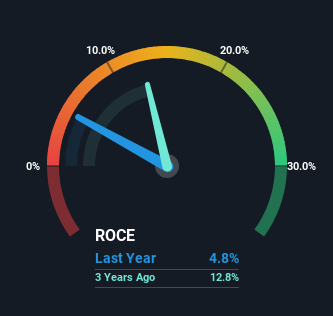Returns On Capital At Carclo (LON:CAR) Paint A Concerning Picture
What financial metrics can indicate to us that a company is maturing or even in decline? A business that's potentially in decline often shows two trends, a return on capital employed (ROCE) that's declining, and a base of capital employed that's also declining. This reveals that the company isn't compounding shareholder wealth because returns are falling and its net asset base is shrinking. On that note, looking into Carclo (LON:CAR), we weren't too upbeat about how things were going.
What Is Return On Capital Employed (ROCE)?
For those who don't know, ROCE is a measure of a company's yearly pre-tax profit (its return), relative to the capital employed in the business. To calculate this metric for Carclo, this is the formula:
Return on Capital Employed = Earnings Before Interest and Tax (EBIT) ÷ (Total Assets - Current Liabilities)
0.048 = UK£4.4m ÷ (UK£123m - UK£32m) (Based on the trailing twelve months to March 2023).
Therefore, Carclo has an ROCE of 4.8%. Ultimately, that's a low return and it under-performs the Chemicals industry average of 12%.
View our latest analysis for Carclo
While the past is not representative of the future, it can be helpful to know how a company has performed historically, which is why we have this chart above. If you'd like to look at how Carclo has performed in the past in other metrics, you can view this free graph of past earnings, revenue and cash flow.
So How Is Carclo's ROCE Trending?
In terms of Carclo's historical ROCE trend, it isn't fantastic. Unfortunately, returns have declined substantially over the last five years to the 4.8% we see today. What's equally concerning is that the amount of capital deployed in the business has shrunk by 22% over that same period. The fact that both are shrinking is an indication that the business is going through some tough times. If these underlying trends continue, we wouldn't be too optimistic going forward.
The Bottom Line
In short, lower returns and decreasing amounts capital employed in the business doesn't fill us with confidence. We expect this has contributed to the stock plummeting 87% during the last five years. Unless there is a shift to a more positive trajectory in these metrics, we would look elsewhere.
Carclo does come with some risks though, we found 3 warning signs in our investment analysis, and 2 of those are a bit concerning...
While Carclo may not currently earn the highest returns, we've compiled a list of companies that currently earn more than 25% return on equity. Check out this free list here.
Have feedback on this article? Concerned about the content? Get in touch with us directly. Alternatively, email editorial-team (at) simplywallst.com.
This article by Simply Wall St is general in nature. We provide commentary based on historical data and analyst forecasts only using an unbiased methodology and our articles are not intended to be financial advice. It does not constitute a recommendation to buy or sell any stock, and does not take account of your objectives, or your financial situation. We aim to bring you long-term focused analysis driven by fundamental data. Note that our analysis may not factor in the latest price-sensitive company announcements or qualitative material. Simply Wall St has no position in any stocks mentioned.

